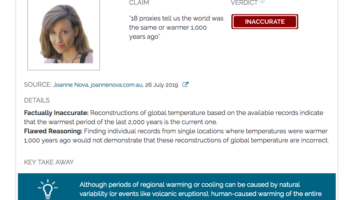- Climate
Research does not show a Medieval Warm Period warmer than the present day
Key takeaway
Although periods of regional warming or cooling can be caused by natural variability (or events like volcanic eruptions), human-caused warming of the entire planet has led to the highest global temperatures of the last 2,000 years.
Reviewed content

Verdict:
Claim:
18 proxies tell us the world was the same or warmer 1,000 years ago
Verdict detail
Factually Inaccurate: Reconstructions of global temperature based on the available records indicate that the warmest period of the last 2,000 years is the current one.
Flawed Reasoning: Finding individual records from single locations where temperatures were warmer 1,000 years ago would not demonstrate that these reconstructions of global temperature are incorrect.
Full Claim
This new global temperature reconstruction by The Pages Consortium miraculously agrees with the models yet disagrees with hundreds of stalagmites, corals, ice cores, trees, lake sediments, mud from the ocean floor, pollen dust and 6,000 boreholes[...] 18 proxies tell us the world was the same or warmer 1,000 years ago
A recent study1 analyzing a global database of paleoclimate records found that no previous warm or cool period in the last 2,000 years—including the Roman Warm Period and the Medieval Warm Period (also called the Medieval Climate Anomaly)—occurred globally and synchronously. But 20th Century temperatures were the warmest of the last 2,000 years for nearly the entire surface of the Earth.

Source: Neukom et al (2019)1
- 1- Neukom et al (2019) No evidence for globally coherent warm and cold periods over the preindustrial Common Era, Nature

Associate Professor, The University of Arizona
[This comment is taken from a previous review of a similar claim.]
1) Our most up-to-date understanding of global mean temperatures is likely the Last Millennium Reanalysis1. Even accounting for uncertainties, global mean annual temperatures are higher now than any time in the last 2,000 years, with the middle of the 20th century either matching or exceeding Common Era temperatures as well.
2) For the Northern Hemisphere (where we have much better proxy data and a better understanding of the uncertainties), we come to similar conclusions—in Wilson et al (2016)2 we find that the two warmest decades of our reconstruction (from 918 to 2004 CE) were 1994–2003 and 1946–1955. Coming in 3rd place is 1161–1170 CE. So, the latest in large-scale temperature reconstructions do NOT support a claim that temperatures either in the Medieval or Roman periods were warmer than today.
3) Even if these periods were warmer than today (and we currently have no evidence that they were), that would have no bearing on whether CO2 is causing current warming. Current warming is unambiguously caused by CO2 emissions. Past warm and cold periods reflect a mix of internal climate system variability and changes in radiative forcing from volcanoes and solar variability. Current warming is the result of rising atmospheric CO2 concentration, whether or not there were past epochs of widespread warming.
- 1- Tardif et al (2019) Last Millennium Reanalysis with an expanded proxy database and seasonal proxy modeling, Climate of the Past
- 2- Wilson et al (2016) Last millennium northern hemisphere summer temperatures from tree rings: Part I: The long term context, Quaternary Science Reviews

Professor, University of St Andrews
[This comment is taken from a previous review of a similar claim.]
Since 2015, several tree-ring based studies of large-scale Northern Hemisphere summer temperatures have shown that the last 10 or 20 year periods are significantly warmer than any other time for the last 1,200 years. A recent study in Nature1 has expanded on this work using a global multi-proxy data-set which suggests that the last 50 years have been warmer than any period of the last 2,000 years.
The statement above is therefore incorrect and mis-characterises what is detailed in many studies. In fact, basic conclusions have been rather consistent over the past 20 years—i.e., recent warming is unprecedented for the last millennium (likely for last 2,000), the Sun has almost no detectable attributed impact on climate, and volcanoes have the strongest impact on climate prior to the anthropogenic period. Our knowledge of past climate is better where we have data and poor where we rely on teleconnections and/or interpolation.
However, the paleoclimate community and users of the data we generate must appreciate that the 1st millennium of the Common Era is substantially much less constrained than the last 1,000 years and more effort and investment is needed to increase the number of climate proxy records for this earlier period (also the Medieval). Ideally, we should not mix proxy records that express different signals as the climate response to both internal and external forcing varies across different seasons (i.e., summer vs. winter). I would also contentiously add that for the late Holocene, we should minimise the use of proxy archives with poor (>10 years) resolution and substantial (+/- 5-10 years) dating uncertainties.
- 1- Neukom et al (2019) No evidence for globally coherent warm and cold periods over the preindustrial Common Era, Nature



